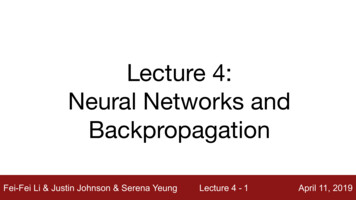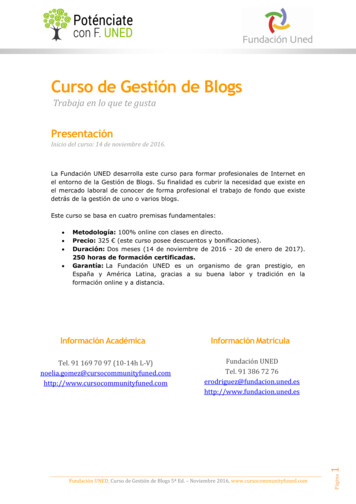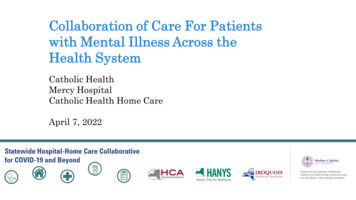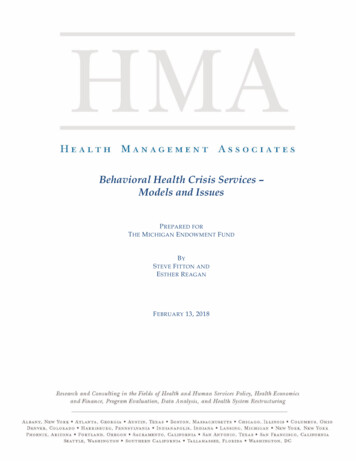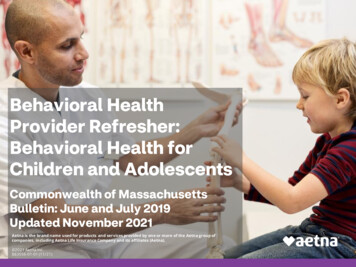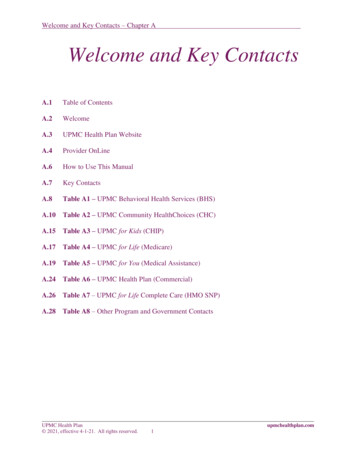
Transcription
FEI Behavioral HealthBest Blogs 2015800.987.4368www.feinet.com
table of contentsintroductionmanagerexchangeHR and EAP: A Not-So Odd CoupleUnderstanding and Evaluating Equity in the WorkplaceRespectful Communication in the WorkplaceWhat’s Going On Here? Overcoming Negative Cycles in the WorkplaceHigh Conflict EmployeesFatigue ManagementManaging Work Groups during a Corporate PurchaseReducing the Stress and Burnout Factor at WorkWhy Employees Don’t Use EAP ServicesWhen Personal Problems Come to WorkReimagining Wellness: Putting People FirstProject Management: Don’t Let Communication Be the LimitationcrisismanagementSafeguarding Personal Data Against HackersFielding Calls After a CrisisPreparedness: A Continual ProcessA Trauma-Informed Approach to Crisis ManagementHow Strong is your Crisis Communication Plan?The Power of a NetworkA Review: Emergency Communications SystemsPeople with Disabilities Lead the Way in Crisis PreparednessDisseminating Sensitive Information Deserves a Sensitive ApproachDeveloping a Sense of Situational AwarenessNo Longer Living in FearAfter the Tragedy: Is It Ever Really “Over”?
introduction2015 was a year rife with tragedy, and perhaps one of the mostturbulent worldwide since the terrorist attacks of 9/11. TheIslamic State carried out numerous attacks, mostly against France,while the developments of U.S. war in the Middle East continuedto escalate. Domestically there were multiple attacks on Americancitizens from at home: the mass shootings of Charleston, SouthCarolina, and Umpqua Community College in Roseburg, Oregon,for example, as well as smaller scale acts of violence. Racial unrestfrom the 2014 events of Ferguson, Missouri, continued to divideand inflame.Yet we mustn’t forget the good because of the bad. Ferguson hasbrought to light longstanding racial tensions and furthereddiscussion of equity in America, including in the workplace.Mental health is being recognized as integral to overall well-being.The economy continues to recuperate and job growth nationwideis on the rise. A new generation of workforce, bringing innovativeideas and fresh perspectives, has come into its own and is workingto overcome generational divides for organizational resilience.FEI Behavioral Health publishes a weekly blog on topics relevant toorganizational management and handling crisis scenarios, writtenby our vast array of subject experts. We’ve compiled the best ofour 2015 material and made it easy for you to explore a variety oftopics that lead to a more resilient and productive workforce, bothinternal and external.We hope you enjoy.
manager exchange“From tips on project management to handling suicidalemployees or addressing fatigue in the workplace, FEI’sManager Exchange blog is your comprehensive resource fororganizational support and professional growth. Our staff ofexperts explore a variety of topics throughout all departmentsof our business, offering relevant content on our suite ofworkplace resiliency programs and services.” Amy Haft, Senior Account Manager
HR and EAP: A Not-So Odd CoupleBy Freya Cooper, FEI Account ManagerJanuary 22, 2015I remember attending my first Employee Assistance Professionals Association (EAPA) meetingabout 10 years ago. I was excited and eager to meet both employee assistance professionalsand human resource practitioners. The excitement slowly turned into confusion as there wereno HR practitioners at the meeting. Later, when I talked to my advisor about mydisappointment in the lack of HR practitioners at the meeting, I asked if this was always thecase. She explained to me that the “two just don’t work together.”Still, I was met with confusion. As a past HR professional with a passion for counseling, I madethe transition to EAP because I felt I would not have to abandon my HR experience. I could seethe benefit of the two working together almost immediately. After all, both had a common goalof helping to improve the work performance of individuals which would be for the greater goodof companies.There are several benefits to EA and HR professionals forming a partnership. Having a laborforce that has realized an advanced level of stability between their personal and professionallives is beneficial to the organization as a whole. Employees who experience social problemsdistressing themselves and their families can be assisted through proactive involvement by EAprofessionals. Research shows employers see significant ROI when providing help to employeesdealing with emotional and personal issues.Additionally, EA and HR professionals working closely together will often lead to greaterawareness of an employer’s workplace culture. That places the EA professional in a betterposition to suggest effective solutions to fit the employer’s needs. These could include benefitfairs, management consultation, customized trainings or literature to address a particularconcern made available to employees.So, why isn’t there an alliance between the two professions? Perhaps this can be attributed tothe traditional roles of both, in addition to their specific responsibilities and obligations. Oneparticular area of concern regarding collaboration lies in compliance. Because employers havean obligation to look out for employees who are struggling in the workplace, both professionsmust find a way to work together to successfully use the current laws, as well as other tools, tobring balance back to the employee. This can be done while recognizing the legal, moral andethical restrictions that must be maintained between the HR Practitioner and the EAProfessional.table of contentsmanager exchange
Understanding and Evaluating Equity in the WorkplaceBy Undraye Howard, Vice President of the Alliance Center on LeadershipFebruary 6, 2015It’s 2015, and representation for persons of color across social and cultural norms has grownsubstantially since the new millennium. Regardless, we continue to struggle with an overallsense of equity for everyone. Factors such as discrimination and structural racism continue toplay a large part in the way organizations and institutions operate.Embracing and encouraging equity is one of many steps that must be taken for organizations toflourish in the coming years. Strides have been made to reduce wage gaps for women andpersons of color over the past few decades, but gaps remain. According to the Annie E. CaseyFoundation, “In the 21st century, the strength of an organization will be measured by how wellequity, diversity and inclusion are embedded in its everyday way of doing business.”Some organizations have assessment tools established to analyze equity, and it would beprudent for employers to explore these tools if they are available. When evaluating equity inyour workplace, here are some criteria to possibly consider: Compensation: Organizations can look closely at their compensation structures todetermine gaps between top and lowest paid positions, gender, age, education and race. Arethere such gaps? How can they be improved? Benefits: Review the benefits and health of employees across race, gender andcompensation levels. If a health club benefit is given to someone who doesn’t have access toa health club–perhaps they live too far away to justify gas expenses or don’t own a car–thenthis is not an equitable benefit. Are your organizational benefits fair for employees acrossthe board? Community Economic Contributions: Who does the organization hire and where do theyhire from? Are employees representing the greater community makeup? When doingbusiness, is an attempt to contract with Minority Owned Businesses intentionally made? Organizational Climate: Do staff feel included in the systems of power? What is turnover bygender, age and race? Does the leadership team represent staff proportionally?table of contentsmanager exchange
Respectful Communication in the WorkplaceBy Gary Skaleski, FEI EAP CounselorFebruary 18, 2015In the spirit of paying it forward, I would like to discuss the work of Mark Andreas, son of two ofthe most effective communicators and trainers I have had the privilege to meet. Mark is on hisway to joining that elite group. What he has to say about communication can be adapted for awide variety of contexts, including the workplace. The essence of his work has to do with theway we approach and define our relationship with others, and the consequences that can haveon effective communication.When interacting with others, do you tend to talk TO or AT them, or do you instead talk WITHthem about the issue at hand? The differences between these two statements turn out to bemuch more profound than they first appear.Let’s do a thought experiment. Close your eyes and recall a time when someone was talking, asyou would define it, TO or AT you. How did this make you feel being talked to like that? Did itmake you feel smaller, defensive, upset or angry? Sit with this experience for a while.Now imagine the same scenario, but imagine the other person talking WITH you about thisissue. Think about times where you felt more as an equal, working together with one another,and how the words and tonalities made you feel included and not defensive.Generally, when one is approached by being talked AT, one feels put down or punished, as if aparent is scolding them. This results in a negative mood or state and is not in line with ability toproblem-solve.When one gets the sense of being talked WITH, one feels more like an equal, included or ateam member. They feel they have the right to put forth ideas without fear of being rejected orput down. This allows one to be more productive and in a problem-solving mood.Respectful communication is crucial to effective leadership. By studying the differencesbetween these two modes of communication, managers can discover how and what to say toallow employees to feel more accepted and engaged in the organization. This will allow foremployees to want to become contributing and ultimately highly productive members of theworkforce.table of contentsmanager exchange
What’s Going on Here? Overcoming Negative Cycles in the WorkplaceBy Julie Sharp, FEI Account ManagerMarch 6, 2015You have two employees who are constantly in conflict, creating a negative work environmentfor your entire team. The relationship between employees and management in yourorganization is fraught with tension, distrust and mutual suspicion. You suddenly find yourdirect report acting guarded and withdrawn in response to your direction for no reason thatyou can identify. You then find yourself suspicious and acting toward them in a way that isaltered and uncomfortable.Exactly what is going on here? It may be that you are observing or experiencing a “fear cycle” or“conflict cycle,” or as Ann Maravelas calls it in her book How to Reduce Workplace Conflict andStress, a “Cycle of Contempt.” These are unconscious patterns of interacting that developbetween spouses, friends, co-workers, even organizations and nations, usually based onerroneous assumptions and acted out to a detrimental outcome.It works something like this: Our thoughts influence our feelings, which influence our behavior,which may then trigger a response in another person that confirms our original thought. At thesame time, the other person is experiencing a similar response, creating a perpetuating cycle ofmisunderstanding. This cycle can lead to conflict and eventually broken relationships,dysfunctional workplaces or worse.Maravelas tells the story of a seminar participant that related how, many years ago, heryounger brother had become addicted to cocaine and subsequently stole his mother’s car. Indesperation, the mother called the police, which led to the son’s arrest and time in prison.There was no communication between the two and after his release his sister forced a meetingbetween the two of them. In this meeting they discovered that they both wanted to bereconciled but each assumed that the other would not. The son assumed his mother would notwant to see him because he stole her car. The mother assumed the son would not want to seeher because she had turned him in to the police.How do these cycles get started? Usually it starts with an erroneous thought such as, “thisperson is unreasonable, lazy, cold, etc.” However, it is possible for these cycles to be broken byinstead reacting with thoughts such as, “this person is reasonable, there must be a good reasonfor their behavior. Perhaps it may even be a reaction to my behavior towards them.”Most of us have had an experience where we have built up a negative explanation for anotherperson’s behavior and responded accordingly, only to discover a new understanding thatchanges everything in an instant. If you are stuck in a negative cycle with an employee, it can behelpful to speak with an EAP Account Manger to get perspective on how to replace thisdestructive pattern with a more constructive dynamic. At FEI, we can assist you with navigatingdifficult relational issues such as these in order to help you to create a more positive, resilientenvironment for your entire organization.table of contentsmanager exchange
High Conflict EmployeesBy Marcia O’Boyle, FEI EAP Services Center ManagerApril 1, 2015A “high conflict employee” is a term used to identify certain employees who seem to thrive increating or engaging in drama and conflict in the workplace. Characteristics of high conflictemployees include aggressive behavior such as yelling, loud swearing or intimidating stance;refusing to speak to or look at others though required as part of their duties; or sending hostileemails, unfounded accusations or malicious rumors. These individuals are often preoccupiedwith believing they are a victim and make an attempt to recruit sympathizers for theirsituations. They may also be aggressive/passive aggressive, defensive, inflexible or blameothers.The costs of high conflict employees to an organization can be high. Morale suffers–not only forpeople directly involved, but others who witness or are aware of the conflicts are also affected.Disruption in the workplace may include “presenteeism,” whereby employees may bephysically present, but are not productive. Gossip and fear may interfere with performance.Stress may cause some co-workers to become ill. If left unaddressed, some employees maydecide to leave the situation and their jobs.In addition to the costs of lowered productivity caused by the distraction of conflict, if itbecomes necessary to replace an employee due to termination or resignation, this problem willincur further expense. Some of the costs include having other employees cover the work orrecruiting and training a replacement. In addition, staff turnover can further lower morale. Eventhe reputation of the organization can become damaged if not appropriately resolved.Proper steps must be taken in order to address a high conflict employee. Managers must firstaddress the problem, immediately confront and document unacceptable behavior, and ensurean appropriate and fair investigation of the situation. The employee should be held accountableand provided with clear, written expectations and progressive disciplinary actions. It is best formanagement to approach high conflict employee problems quickly and as a coordinated,supportive team. The intervention by more than one management team member helps diffusethe situation and inhibit potential divisiveness.table of contentsmanager exchange
Fatigue ManagementBy Amy Haft, FEI Senior Account ManagerApril 14, 2015A recent article in Employee Benefit Advisor suggested that one of the trends to watch for in2015 is the emergence of fatigue management programs in the workplace. This issue has beenon the radar of the Wellness Council of America (WELCOA), a respected resource for workplacewellness, for the past several years. WELCOA previously published an interview with Dr. JoeLeutzinger in WELCOA's News & Views entitled “Fighting Fatigue – Overcoming Fatigue andLow-Energy Issues in the Workplace.”According to this interview, workers with fatigue have been shown to be less productive andmore prone to illness. Workers who come to work fatigued are distracted and more likely to beinvolved in a safety sensitive incident. Even more alarming, research reveals that fatigue canimpair performance consistent with being at or above legal blood alcohol content levels. As tothe cost and magnitude, the Journal of Occupational and Environment Medicine indicates thatapproximately 38 percent of U.S. workers experience fatigue, costing companies about 136billion in lost productivity.What plan of action can employers take to curb this trend?WELCOA has outlined some excellent strategies on worksite health and productivity issues inthe U.S. Addressing the company culture is a key element. As you review your company’spolicies and procedures to see if they are conducive to healthy behaviors, include sleep andfatigue. One strategy is to ask employees, especially those in safety sensitive positions, on ascale of one to ten how sleepy they feel during the day or before they begin work. Based ontheir responses, policies and procedures could be put in place to provide breaks and healthyfood options to help employees address the times when they feel particularly fatigued.In addition, below are some suggestions to integrate a Fatigue Management Program withoverall health improvement initiatives. Embed sleep disorder questions within your Health Risk Appraisal (HRA). Initiate a campaign to educate employees about proper sleep hygiene. Identify modes for diagnosing and treating sleep apnea. A good resource for additionalinformation is the National Sleep Foundation. Track the fatigue and productivity connection on a periodic basis. If schedules for shift workers are rotated, provide these workers with enough time for theirbody to adjust to the schedule.The signs and symptoms of fatigue include a laundry list of issues related to mental health:depression, stress, anxiety. It is important to recognize the potential impact in the workplaceand on the quality of life. Your Employee Assistance Program is an excellent resource to beginto explore solutions to address this important issue.table of contentsmanager exchange
Managing Work Groups during a Corporate PurchaseBy Jon Buchler, FEI EAP CounselorMay 15 & 18, 2015If you spend enough years in the workforce, then you will almost certainly live through achange of ownership of a company. Change of ownership usually means that changes inworkforce organization and deployment follow. Even when a change of ownership clearlyrepresents a step forward for the company, the transitional period following a corporatetakeover or merger brings anxiety into the workplace.The change process is sometimes well managed, with clear plans and forthright communicationto employees. However, there is often a period of time when the plans for change are unknownand employees live with uncertainty. This can be a time of anxiety, resentment, resistance ordepression. If things aren’t handled well, morale suffers.During a corporate takeover or merger, supervisors are challenged to manage their ownfeelings and concerns, as well as employees. This is no small task. Employees worry about theirjob security and about the changes that may come to their work day, even if their jobs survivethe change. Managers are faced with the task of providing as much assurance as they canwithout making promises they may not be able to keep.Changes resulting from corporate sale are almost always “top-down” changes. Reorganizationto achieve efficiencies of scale is commonplace and entire departments of companies can beeliminated. Staff departures are commonplace, and managers must decide whether or not tohire replacements without knowing if the jobs will remain in place.Changes in policies and procedures, especially those changes which result in changedconditions of employment and reduction of benefits, are often greeted with resentment andanger. Employees justifiably feel that the new ownership is “taking away” benefits that matterto them. Unless those “takeaways” are balanced by enhancements in other benefits or workconditions, employees can react by becoming angry, withdrawn, sullen or bitter. When thosefeelings spread through a workgroup, the drop in morale creates a very toxic workenvironment.So what can be done to decrease resentment and increase employee morale and productivityduring times of corporate change? To understand how to best manage during times ofcorporate change, consider the following scenario:Company ABC, which manufactures and sells auto parts to distributors and chain stores, ispurchased by Company XYZ, a former competitor in the marketplace. There are four insidesales groups of eight sales persons each at Company ABC at the time of the purchase. Eachsales group has a manager. Tom manages Sales Group 1 and Sally manages Sales Group 2. Bothhave a long history as managers for Company ABC and most of their sales associates are“veterans.”table of contentsmanager exchange
Tom becomes very concerned about his job security at the time of the corporate purchase. Heis in his mid-50s and worries that he would have a very hard time finding a new job that wouldpay him an equivalent salary if he were released from employment. He has two children incollege and just manages to pay the bills now. While he makes an effort to build a relationshipwith the director of inside sales who has been put in place by Company XYZ, he doesn’t thinkthey are making a connection. He quietly but rapidly begins a job search. With his attentionfocused elsewhere, he doesn’t spend much time and energy on working with the team hemanages. He holds all the expected meetings, counsels his supervisees to work hard to meetnew production standards and to demonstrate their value to the new ownership, but he isdistracted and doesn’t provide much encouragement or leadership.Sally’s concerns are similar to Tom’s, but she decides that she wants to stay with the newmerged company and build her career there. She has accumulated benefits and seniority anddecides her best course of action is to “put both feet in.” She knows that a high-performingteam will reflect well on her and increase the likelihood that she will be retained as changes aremade in the sales area of the new company.Initially, Sally extends the time for the weekly team meetings to deal with the issues that havearisen as a result of the company sale. She communicates information about the changesoccurring in the company, especially in the sales arena. She states clearly to the team that oneof her key goals is to demonstrate to the new director of inside sales that their team represents“best value” to the company as a high performance group. When the sales targets for her staffare increased by 30 percent from the previous year, she works hard with her team members tohelp them figure out how to reach the new targets. She holds one-on-one meetings with herassociates to provide encouragement, support and plans to achieve targets. She seeks topersuade the new sales director to hire an administrative assistant to enter data, in order tofree her staff up to spend more time in sales solicitation. She invites the director of sales tomeet with her team to clarify expectations and asks him to provide reassurance that employeeswho meet the new targets will be retained by the company.During the first month following the sale of the company, three of Tom’s sales associates leavethe company to take other positions. This places increased pressure on the remaining salesassociates. In the absence of strong leadership from Tom, morale suffers. Lunchroomconversation is filled with bitter complaints about changes and the increased sales targets,which are viewed as impossible to achieve.table of contentsmanager exchange
During the same time period, one sales associate from Sally’s team leaves the company. Thisemployee had been falling short of sales targets before the sale of the company and hadrealized that she could not succeed in the new merged company. All other sales associateswere exceeding their previous performance and most of them were “on target” to meet thestandard of sales recently established. Sally found that the new director of inside salesconsulted with her about other teams in the sales area. He looked to her to help him buildrelationships with the other sales team managers and associates. She became his trusted allyand her team was recognized for “getting with the program.”When the sifting and winnowing of staff assignments occurred, Tom was let go and hisassociates were released, as well. Sally, on the other hand, was eventually promoted within thenew merged sales department and all her sales associates remained with the company. The keyto Sally’s success was clearly her decision to embrace change and find savvy ways todemonstrate her allegiance and value to the new company, as well as the value of her team.Change can be challenging and even threatening. However, change is inevitable. Vibrantorganizations are always changing. Finding a way to embrace change, even when that changemay seem threatening, is often the key to a successful managerial career.table of contentsmanager exchange
Reducing the Stress and Burnout Factor at WorkBy Holly Wasechek, FEI Employee Assistance RepresentativeJune 10, 2015In this day and age, we are constantly being bombarded with demands in both our work andpersonal lives. Sooner or later, these demands will take a toll on us and ultimately ourcompanies. High-stress environments can lead to burnout and high turnover for stressedworkers, costing business more in the long run if they are not addressed properly. According tothe American Institute of Stress, job stress due to increased absenteeism, employee turnover,diminished productivity and medical expenses costs U.S. businesses more than 300 billionannually.As a manager you have a responsibility to provide a work environment that supports the overallwell-being of your employees. Providing tools and resources to combat stress that canadversely affect your employees’ physical and mental well-being is the most effective way toensure a resilient workforce and successful organization.Assessing the risks that stress poses to your workers and acting on this assessment is vital. Toassist with this process, consider the following steps: Identify possible stressors and the risk that they pose Is the organization and management well structured? Do employees’ skills and knowledge match the needs of their role as closely aspossible? Does your work environment promote safety, comfort, teamwork and socialization? Are employees provided with the resources they need to do their job successfully? Develop an action plan to minimize risk of stress Ensure all employees are provided with a clear job description and responsibilities Identify necessary staff training topics and sessions that would benefit bothemployees and managers Determine what additional resources should be purchased or supplied to employees Implement an action plan Provide Employee Assistance Program (EAP) and Work-Life services to assistemployees in dealing with common stressors such as legal/financial issues,marriage/relationship problems, child/elder care needs and alcohol/substance abuse Provide clear communication to employees at all times, especially in regards toorganizational changes Evaluate the plan’s success Talk to employees and make note of any additional concerns they might have If further action is required or there are particularly challenging situations, utilizemanagement consultation services available through your EAPtable of contentsmanager exchange
Why Employees Don’t Use EAP ServicesBy Nancy Vogt, FEI Account ManagerJuly 10, 2015The Employee Assistance Program (EAP) is such a valuable benefit that it can be hard foremployers to understand why employees don’t make full use of it. Organizations that have anEAP provider may already know it has great value as a coaching resource, a career-rescue tooland as a literal lifesaver for employees who are under severe personal and professional stress. Sowhy don’t employees utilize it?There are four main reasons why employees don’t use the EAP:1.2.3.4.They don’t think it’s confidential.They feel there is a stigma for reaching out for help.They think they have to ask permission from their boss or HR.They don’t know it exists.Let’s talk about each one. First, company stakeholders need to continually educate employeesabout how the EAP works, starting with the fact that it is absolutely confidential (unless theclient wants to harm him or herself or others, then the therapist has a duty to warn orintervene). Employees also need to be reminded that the only information that comes back tothe organization is purely demographic and that there is no external record of their use of theEAP.Second, it makes sense to reassure employees that every one of us has similar on and off-thejob struggles. It’s completely normal for people to reach out for help when they are exposed torepeated or chronic stress, which can in fact damage the body in the long run. Make sure youremployees know what subjects the EAP covers, including but not limited to: Financial problemsMarital issuesRaising children or step-childrenBlended familiesSick kidsCancerStress-related illnessParents with Alzheimer’sGrief from death or lossAt-work or line of duty deaths Gambling problemsMoney worriesSubstance abuseEating disordersJob burnoutWorkplace conflictsDepressionSuicidal thoughtsEach of these concerns can be addressed urgently and competently by the EAP.table of contentsmanager exchange
Third, just as the use of EAP is confidential, there is no need for employees to tell anyone, askpermission, go through HR channels or do anything other than call the EAP phone number andmake an appointment.Lastly, in orde
2015 was a year rife with tragedy, and perhaps one of the most turbulent worldwide since the terrorist attacks of 9/11. The Islamic State carried out numerous attacks, mostly against France, while the developments of U.S. war in the Middle East continued to escalate. Domestically there were multiple attacks on American

